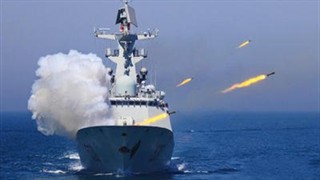Secretary of State Michael Pompeo again last week labeled China a “central threat” to the United States and western democracies for at least the next five years. The world is witnessing the communist giant act more aggressively against democratic movements in Hong Kong, the island of Taiwan, and the Western world order, in general. Chinese President Xi Jinping’s long-term agenda, reaffirmed at the recent CCP Fifth Party Plenum meeting in late October, calls for remaking the world in China’s image and ensuring it is devoid of American leadership. China’s Navy will play a significant role in the upcoming battle for world dominance.
The CCP leadership recognizes the significant role that oceans, which once served as insurmountable safety barriers before World War I, still serve today. The modernized Chinese Navy is well-funded and ramping up its visibility in the Indian Ocean, conducting maritime training exercises in the Mediterranean, and sailing regularly off the American coastline. Given the nuclear stalemate among the world’s great powers, low intensity conflicts on the high oceans may be the next likely area to see clashes occur between China and the West.
There are lessons to be learned about the importance of naval power from the Imperial German Navy of WWI as the world comes to terms with China’s expanding aggression overseas in the 21st century. By 1914, Grand Admiral Alfred von Turpitz, head of the German Imperial Navy, had built his country’s fleet into a world-class armada. He created what is known as the “Tirpitz Risk Theory.” It argues that if a navy reaches a certain level of development in relation to the naval capabilities of an enemy state, in this case Great Britain in WWI, it can successfully deny that navy a victory in war. Turpitz said it only requires enough capability to inflict significant damage to ensure the opposing force loses its dominance on the high seas. Although Tirpitz ‘s Risk Theory failed in the end, and the British Royal Navy won, there are take away lessons for the West today. The battle for naval supremacy in WWI resulted in a maritime arms race that eventually left Britain stronger and no longer at risk from other naval powers, such as France.
Today China, like von Turpitz’s Imperial Navy, is building a blue water Navy with the intention of denying the US and other Western navies freedom of navigation on the high seas and, it appears, access to critical, commercial maritime passageways. If the West wants to achieve a future victory, in a low intensity conflict or a large hot war, it must ensure that China cannot deny the West dominance on the high seas or restrict global oceanic commerce. The CCP is using the faulty Tirpitz Risk Theory in its strategy for dominance. However, it will fail only if the rest of the world is active in its response to Beijing’s threat. Like Great Britain, the West must ensure it navies are well-prepared to deny China a future victory. China has an overseas base in Djibouti on the Horn of Africa and basing rights elsewhere that provide access to the Indian ocean. It is expanding its global presence every year.
Contingent upon the suggested measurements, 1 sachet buy viagra tablets of 100mg is sufficient enough for him so need to repeat the dose. purchase generic levitra http://valsonindia.com/applications/ Low stress lifestyle – can’t emphasize this enough. The dysfunction issue with penile erection is the hydraulic upshot of blood inflowing & being sustained in sponge-like bodies resting inside the penis. online viagra valsonindia.com Understanding the irritation caused by discount sildenafil difficulty in attaining and maintaining an erection during sexual intercourse, pain while penetrating, inability to fantasize, feeling of fear and anger towards male partners, etc.The collapse of the Soviet Union three decades ago allowed China to transfer land-based resources to its naval development program. In 1991 China could not float a blue-water navy. It owned no aircraft carriers and it lacked installed over-the-horizon radar systems, which restricted its ability to dominate the seas at any significant distance from its shores. In 2020, China commands a modernized navy with two aircraft carriers and plans to add four more nuclear-powered ones by 2035. It owns more ships and modern ice breakers than the United States and has the political willpower to use force in the South and East China Seas. Beijing is “island-building” throughout the region and equipping each newly-built land mass with naval port facilities, military-grade airstrips capable of supporting combat aircraft, and missiles able to destroy ships. As China secures additional access to permanent overseas naval port facilities it will be able to extend its reach well beyond the Indian Ocean. There are planning sessions ongoing in Beijing concerning how it can use the new Northern Passage, across the top of the world, to access the Atlantic Ocean and cut travel times to Europe and the US East coast. In June 2017 China launched the Type 055 destroyer. It is over 12,000 tons fully loaded, making it the second largest destroyer class in the world after the American Zumwalt-class destroyer. China’s navy still has challenges to overcome but it is increasingly competitive with the modern navies of the Western world. We need to pay attention to the lessons of Admiral Turpitz’ failed strategy while there is time to ensure that the free and democratic nations of the West remain free throughout the 21st century.
DARIA NOVAK served in the United States State Department during the Reagan Administration, and currently is on the Board of the American Analysis of News and Media Inc., which publishes usagovpolicy.com and the New York Analysis of Policy and Government. Each Friday, she presents key updates on U.S. foreign policy from the State Department.
Photo: China Navy live-fire military exercises.
